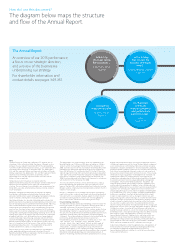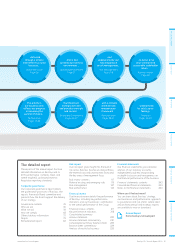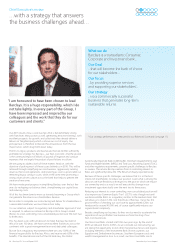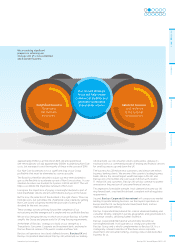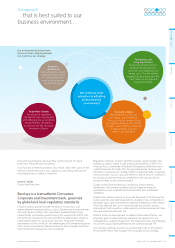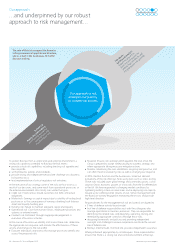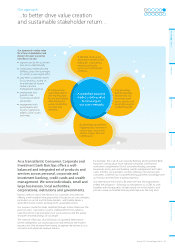Barclays 2015 Annual Report Download - page 2
Download and view the complete annual report
Please find page 2 of the 2015 Barclays annual report below. You can navigate through the pages in the report by either clicking on the pages listed below, or by using the keyword search tool below to find specific information within the annual report.
Barclays PLC Annual Report 2015 home.barclays/annualreport
How do I use this document?
The diagram below maps the structure
and flow of the Annual Report.
The Annual Report
An overview of our 2015 performance,
a focus on our strategic direction,
and a review of the businesses
underpinning our strategy.
For shareholder information and
contact details see pages 349-351.
…through our
broad service offer.
Business model
Page 10
Addressing
the issues facing
Barclays today…
Chairman’s letter
Page 02
…with a strategy
that answers the
business challenges
ahead…
Chief Executive’s review
Page 04
Our Balanced
Scorecard
measures progress
and performance
against our goal…
KPIs
Pages 11-16
Notes
The term Barclays or Group refers to Barclays PLC together with its
subsidiaries. Unless otherwise stated, the income statement analysis
compares the year ended 31 December 2015 to the corresponding
12 months of 2014 and balance sheet analysis as at 31 December 2015
with comparatives relating to 31 December 2014. The abbreviations
‘£m’ and ‘£bn’ represent millions and thousands of millions of Pounds
Sterling respectively; the abbreviations ‘$m’ and ‘$bn’ represent millions
and thousands of millions of US Dollars respectively; and the
abbreviations ‘€m’ and ‘€bn’ represent millions and thousands of
millions of Euros respectively.
Comparatives pre Q214 have been restated to reflect the
implementation of the Group structure changes and the reallocation of
elements of the Head Office results under the revised business
structure. These restatements were detailed in our announcement on
10 July 2014, accessible at home.barclays/barclays-investor-relations/
results-and-reports
References throughout this document to ‘provisions for ongoing
investigations and litigation including Foreign Exchange’ mean
‘provisions held for certain aspects of ongoing investigations involving
certain authorities and litigation including Foreign Exchange.’
Adjusted profit before tax, adjusted attributable profit and adjusted
performance metrics have been presented to provide a more consistent
basis for comparing business performance between periods. Adjusting
items are considered to be significant but not representative of the
underlying business performance. Items excluded from the adjusted
measures are: the impact of own credit; provisions for UK customer
redress; gain on US Lehman acquisition assets; provisions for ongoing
investigations and litigation including Foreign Exchange; losses on sale
relating to the Spanish, Portuguese and Italian businesses; impairment
of goodwill and other assets relating to businesses being disposed;
revision of Education, Social Housing, and Local Authority (ESHLA)
valuation methodology; and gain on valuation of a component of the
defined retirement benefit liability. As management reviews adjusting
items at a Group level, results by business, Core and Non-Core are
presented excluding these items. The reconciliation of adjusted to
statutory performance is done at a Group level only.
Relevant terms that are used in this document but are not defined
under applicable regulatory guidance or International Financial
Reporting Standards (IFRS) are explained in the Results glossary that
can be accessed at home.barclays/results
The information in this announcement, which was approved by the
Board of Directors on 29 February 2016, does not comprise statutory
accounts within the meaning of Section 434 of the Companies Act
2006. Statutory accounts for the year ended 31 December 2015, which
included certain information required for the Joint Annual Report on
Form 20-F of Barclays PLC and Barclays Bank PLC to the US Securities
and Exchange Commission (SEC) and which contained an unqualified
audit report under Section 495 of the Companies Act 2006 (which did
not make any statements under Section 498 of the Companies Act
2006) have been delivered to the Registrar of Companies in accordance
with Section 441 of the Companies Act 2006.
These results will be furnished as a Form 20-F to the SEC as soon as
practicable following their publication. Once furnished with the SEC,
copies of the Form 20-F will also be available from the Barclays Investor
Relations website at home.barclays/investorrelations and from the SEC’s
website at www.sec.gov
Barclays is a frequent issuer in the debt capital markets and regularly
meets with investors via formal road-shows and other ad hoc meetings.
Consistent with its usual practice, Barclays expects that from time to
time over the coming quarter it will meet with investors globally to
discuss these results and other matters relating to the Group.
Forward-looking statements
This document contains certain forward-looking statements within the
meaning of Section 21E of the US Securities Exchange Act of 1934, as
amended, and Section 27A of the US Securities Act of 1933, as
amended, with respect to the Group. Barclays cautions readers that no
forward-looking statement is a guarantee of future performance and
that actual results or other financial condition or performance measures
could differ materially from those contained in the forward-looking
statements. These forward-looking statements can be identified by the
fact that they do not relate only to historical or current facts.
Forward-looking statements sometimes use words such as ‘may’, ‘will’,
‘seek’, ‘continue’, ‘aim’, ‘anticipate’, ‘target’, ‘projected’, ‘expect’,
‘estimate’, ‘intend’, ‘plan’, ‘goal’, ‘believe’, ‘achieve’ or other words of
similar meaning. Examples of forward-looking statements include,
among others, statements regarding the Group’s future financial
position, income growth, assets, impairment charges and provisions,
business strategy, capital, leverage and other regulatory ratios, payment
of dividends (including dividend pay-out ratios), projected levels of
growth in the banking and financial markets, projected costs or savings,
original and revised commitments and targets in connection with the
strategic cost programme and the Group Strategy Update, rundown of
assets and businesses within Barclays Non-Core, estimates of capital
expenditures and plans and objectives for future operations, projected
employee numbers and other statements that are not historical fact. By
their nature, forward-looking statements involve risk and uncertainty
because they relate to future events and circumstances. These may be
affected by changes in legislation, the development of standards and
interpretations under IFRS, evolving practices with regard to the
interpretation and application of accounting and regulatory standards,
the outcome of current and future legal proceedings and regulatory
investigations, future levels of conduct provisions, the policies and
actions of governmental and regulatory authorities, geopolitical risks
and the impact of competition. In addition, factors including (but not
limited to) the following may have an effect: capital, leverage and other
regulatory rules (including with regard to the future structure of the
Group) applicable to past, current and future periods; United Kingdom
(UK), United States (US), Africa, Eurozone and global macroeconomic
and business conditions; the effects of continued volatility in credit
markets; market related risks such as changes in interest rates and
foreign exchange rates; effects of changes in valuation of credit market
exposures; changes in valuation of issued securities; volatility in capital
markets; changes in credit ratings of any entities within the Group or
any securities issued by such entities; the potential for one or more
countries exiting the Eurozone; the implementation of the strategic cost
programme; and the success of future acquisitions, disposals and other
strategic transactions. A number of these influences and factors are
beyond the Group’s control. As a result, the Group’s actual future results,
dividend payments, and capital and leverage ratios may differ materially
from the plans, goals, and expectations set forth in the Group’s
forward-looking statements. Additional risks and factors which may
impact the Group’s future financial condition and performance are
identified in our filings with the SEC (including, without limitation, our
Annual Report on Form 20-F for the fiscal year ended 31 December
2015), which are available on the SEC’s website at www.sec.gov
Subject to our obligations under the applicable laws and regulations of
the UK and the US in relation to disclosure and ongoing information,
we undertake no obligation to update publicly or revise any
forward-looking statements, whether as a result of new information,
future events or otherwise.


